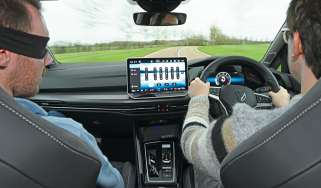Hyundai Tucson (2015-2020) review - Engines, performance and drive
Smooth and powerful engines are offered, but mild-hybrid tech doesn't deliver the cost savings you'd expect

The Tucson was redesigned from the ground up, rather than being a development of the ix35 which it replaced, while updates to the range in 2018 and 2019 introduced new and more efficient engines to the range, including the 48-volt mild-hybrid versions. In terms of ride comfort, the Tucson is a step up from its predecessor and offers supple suspension that can easily deal with potholes and nasty road imperfections.
It’s quiet, too – even in the most powerful 2.0-litre diesel 4WD model, engine noise rarely enters the cabin and it’s a hushed place to be when cruising on the motorway. Despite the soft suspension, body roll is fairly well contained – there’s no unpleasant leaning through fast corners.
With the exception of the eight-speed unit in the top-end 2.0-litre diesel, the remaining automatic gearboxes are all dual-clutch transmissions. The eight-speed auto is smooth and relaxing, but the dual-clutch unit isn’t the best of the breed: it’s easily confused and can be quite laggy – especially when moving off. Unless you really need an automatic, we’d save £1,250 and get the six-speed manual instead.
For most people, the Tucson will be more than adequate to drive, but for those who like their SUVs to be especially sporty behind the wheel the Tucson falls short – the SEAT Ateca and Mazda CX-5, for example, are far more pleasurable and exciting to drive. However, go for the sportier petrol N Line, and thanks to its firmer suspension and revised steering and braking systems, it manages to stay fairly well controlled on a twisty road. Best of all, it doesn’t really come at the expense of ride comfort.
Used - available now

2023 Hyundai
Tucson
9,745 milesAutomaticPetrol1.6L
Cash £21,581
2023 Hyundai
Tucson
24,989 milesAutomaticPetrol1.6L
Cash £23,812
2023 Hyundai
Tucson
31,152 milesManualPetrol1.6L
Cash £18,886
2023 Hyundai
Tucson
8,169 milesAutomaticPetrol1.6L
Cash £26,783In fast bends, the Tucson’s steering doesn’t give you much feedback on what the front wheels are doing – but not much in this class does. It is accurate, though, and on SE models or higher the Flex Steer system increases steering weight at speed.
Engines
Diesel engines are generally best in a car of this type, although petrol power is gaining ground. The 1.6 CRDi diesel gained mild hybrid assistance with the 2019 update, and it's even more fuel efficient than the older 1.7 CRDi. It’s not the most powerful engine in the range with 114bhp or 134bhp to choose from, but it’s up to the job and delivers adequate performance for a family of five.
The mild hybrid system recoups energy under braking that’s stored in a 0.44kWh battery. It can then deploy this power under acceleration, taking as much as 16bhp of load off the combustion unit to save fuel. The set-up is also used to run many of the car’s ancillary electrical systems, which reduces the load a conventional alternator would usually place on the engine, which in turn helps to improve overall efficiency.
The punchy 182bhp 2.0-litre CRDi diesel uses a similar 48-volt electrical system which, as in the 1.6, helps to save fuel by cutting the engine more frequently than a conventional stop-start system. This boosts acceleration, too, and a 9.5-second 0-62mph time is pretty quick for an SUV like this. Maximum speed for models with this engine is 125mph.
If petrol engines are the choice for you, Hyundai has two 1.6-litre options, including a non-turbo that needs plenty of revs to make any progress, the result of which is poor fuel economy and a less relaxed drive. The 1.6 T-GDi, meanwhile, has 175bhp to deliver sprightly performance, and is a much more viable option. It has 265Nm of torque, so while mid-range punch isn't quite up to diesel standards, it's still reasonable, and has a rapid 0-62mph time of 8.9 seconds for the DCT-equipped model. Like the 2.0-litre CRDi, top speed for this engine is 125mph.





